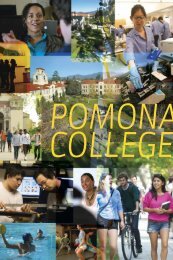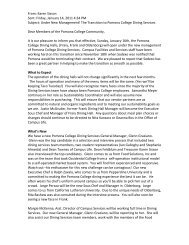Create successful ePaper yourself
Turn your PDF publications into a flip-book with our unique Google optimized e-Paper software.
The phrase “best<br />
Best of Both<br />
WORLDS<br />
THE COLLEGE AND THE CONSORTIUM<br />
of both worlds” has become a<br />
cliché, but at <strong>Pomona</strong>, it’s the simple truth. Our students have the advantages of a small school,<br />
where class size averages 15 and professors teach every class, along with the opportunities<br />
offered by a larger university setting of more than<br />
7,000 students. The founding member of The<br />
Claremont <strong>College</strong>s, <strong>Pomona</strong> is one of five<br />
undergraduate colleges and two graduate institutions<br />
that make up this unique consortium. Unlike other<br />
consortial arrangements, the campuses are contiguous,<br />
and a walk of only a few minutes will take you from one<br />
to another. Although each institution is autonomous,<br />
academic calendars and registration procedures are<br />
coordinated to make cross-enrollment easy.<br />
<strong>Pomona</strong> students may supplement the <strong>College</strong>’s<br />
already comprehensive curriculum by taking classes at<br />
www.pomona.edu/admissions<br />
any of The Claremont <strong>College</strong>s, including some courses at Claremont Graduate University.<br />
With more than 2,000 courses available to them, students may choose from more than 230<br />
English and literature courses, 140 mathematics courses or courses in any of 12 different<br />
languages.<br />
Intercollegiate majors are offered in Chicano/Latino, Black and Asian American studies.<br />
Though mathematics is not an intercollegiate area of study, the curriculum is coordinated by<br />
all of the colleges, giving students access to 60 mathematicians and 140 classes, including 100<br />
upper-division or graduate-level classes, in what may be the most comprehensive program<br />
available at any undergraduate college.<br />
In most cases, cross-enrollment in<br />
classes at another college is as simple as<br />
enrolling in classes at <strong>Pomona</strong>.<br />
Beginning with your second semester,<br />
until the end of your sophomore year,<br />
you can cross-enroll in one class per<br />
term. After that, you can take up to<br />
two courses per term at the other<br />
colleges, subject principally to the<br />
restrictions of your major. Because<br />
there is such a wealth of options at<br />
<strong>Pomona</strong>, students typically take only<br />
eight to 10 percent of their courses at the other colleges.<br />
But an expanded catalog of classes isn’t the only plus. A two-million volume library serves<br />
all of the campuses, and the broad range of speakers’ series, guest lecturers, art exhibits, plays<br />
and performances offered at the other colleges adds immeasurably to the academic<br />
possibilities.<br />
Joining <strong>Pomona</strong> as members of the Consortium are Claremont Graduate University,<br />
Claremont McKenna <strong>College</strong>, Harvey Mudd <strong>College</strong>, Keck Graduate Institute of Applied Life<br />
Sciences, Pitzer <strong>College</strong> and Scripps <strong>College</strong>. Other institutions that are located in Claremont<br />
and more loosely affiliated with the Consortium are the Claremont School of Theology, the<br />
Institute for Antiquity and Christianity and the Rancho Santa Ana Botanic Garden.<br />
Number of minutes of<br />
walking required to reach<br />
the farthest class at any of<br />
The Claremont <strong>College</strong>s:<br />
10 -15<br />
Number of volumes in the<br />
Honnold-Mudd Library:<br />
more<br />
than<br />
2 million<br />
13


![Pomona College View Book [pdf]](https://img.yumpu.com/7994157/14/500x640/pomona-college-view-book-pdf.jpg)
![Anticipated Courses SP14 [pdf] - Pomona College](https://img.yumpu.com/25429326/1/190x245/anticipated-courses-sp14-pdf-pomona-college.jpg?quality=85)

![to download a brochure [pdf] - Pomona College](https://img.yumpu.com/25429319/1/190x245/to-download-a-brochure-pdf-pomona-college.jpg?quality=85)

![Year End Report 09-10 [pdf] - Pomona College](https://img.yumpu.com/25429304/1/190x245/year-end-report-09-10-pdf-pomona-college.jpg?quality=85)
![Download it here [pdf] - Pomona College](https://img.yumpu.com/25429302/1/190x245/download-it-here-pdf-pomona-college.jpg?quality=85)
![Fall 2010 Pomona College Magazine here [pdf]](https://img.yumpu.com/25429298/1/190x219/fall-2010-pomona-college-magazine-here-pdf.jpg?quality=85)
![FAQs for Prospective Music Students [pdf] - Pomona College](https://img.yumpu.com/25429289/1/190x245/faqs-for-prospective-music-students-pdf-pomona-college.jpg?quality=85)
![Year End Report 10-11 [pdf] - Pomona College](https://img.yumpu.com/25429286/1/190x245/year-end-report-10-11-pdf-pomona-college.jpg?quality=85)
![Student Orientation Schedule [pdf] - Pomona College](https://img.yumpu.com/25429282/1/190x89/student-orientation-schedule-pdf-pomona-college.jpg?quality=85)
![Schaefer - 2010 [pdf] - Pomona College](https://img.yumpu.com/25429269/1/190x245/schaefer-2010-pdf-pomona-college.jpg?quality=85)
![C. Freshman Admission [pdf] - Pomona College](https://img.yumpu.com/25429268/1/190x245/c-freshman-admission-pdf-pomona-college.jpg?quality=85)


